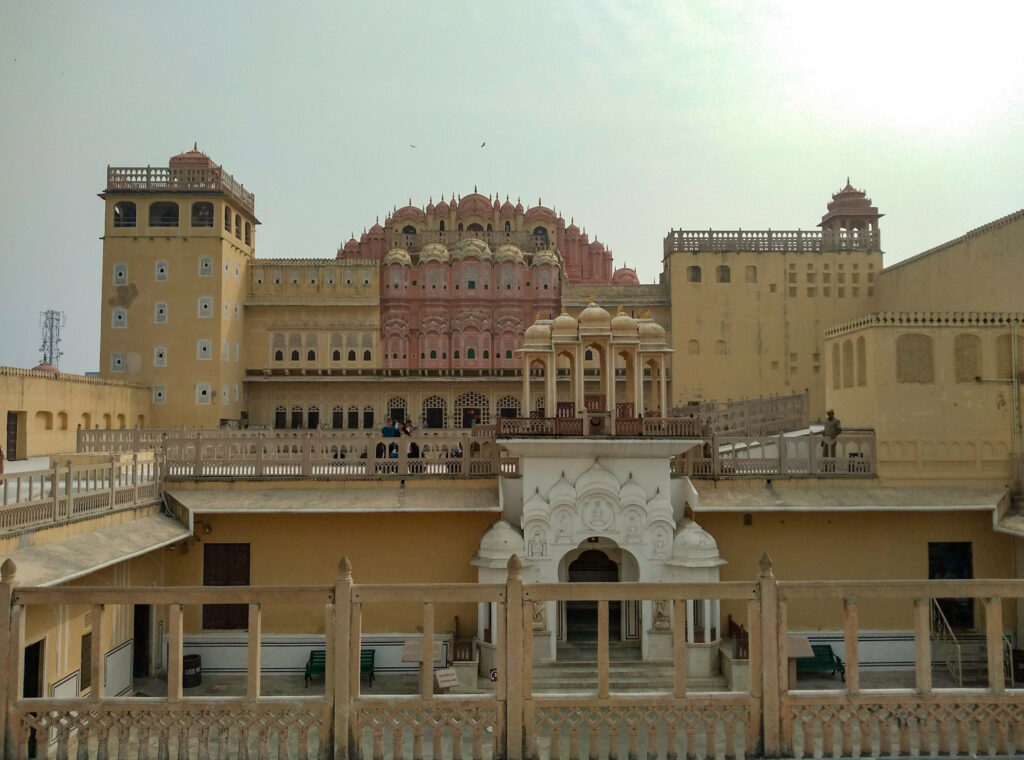“The pink city”.

See photos
Where is Jaipur?
The city of Jaipur is the capital of the Indian state of Rajasthan in the northwest of the country. A popular tourist destination forming part of the Golden Triangle tourist circuit along with Delhi and Agra.
Referred to as the Pink City. It acquired this nickname because every building within the walled city centre is painted a terracotta pink colour.

The painting of the buildings stems from the Maharaja of Jaipur, Sawai Ram Singh II. Wanting to impress Prince Albert during his 1876 tour of India. To try to entice the prince to visit Jaipur during his tour.
The Maharaja constructed a lavish concert hall and named it in honour of the prince. This was a successful strategy. The prince was to visit Jaipur. Wanting to beautify his city for the prince’s impending visit, the Maharaja repainted the whole of the city pink. Historically the colour pink is the colour most associated with charm and politeness.
Jaipur has maintained its distinct colour because the Maharajas’ favourite wife adored the colour scheme. She convinced him to pass a law. To make it illegal for buildings to be painted any other colour than Jaipur Pink. The law was passed in 1877 it still remains in effect today.
Getting there
The journey from Agra to Jaipur was on the train.
Our accommodation
During our time in Jaipur, we chose to stay at the Rawla Rawatsar bed and breakfast
A charming bed and breakfast with traditional wooden furnishings. The room had a seating area and a work desk. The en-suite bathroom had a good shower and complimentary toiletries. We ate at the accommodation on our first night there, having a delicious curry.
Places of interest
There are so many things to see in Jaipur, we felt that we couldn’t see everything without some help. The following morning, we left our accommodation to go sightseeing.
Approached by Sanjay a tuk tuk driver. He offered to take us on an all day tour for 800 Rupees. After some discussion, we decided to go with Sanjay our guide. We had an amazing day sightseeing with him. Sanjay Khan Tuk Tuk Pink City Tour.

During our day with Sanjay, he took us pretty much wherever we wanted to go and gave us some great options with some off the tourist trail places thrown in.
During our day sightseeing, we saw so many animals wandering around the streets of Jaipur. Horses, donkeys, cows, peacocks, monkeys, pigs, boars, squirrels, and even camels.
The first stop on Sanjay’s tour was the Hawa Mahal.

Sanjay advised that the best way to gain entry to all of the places on his tour would be to purchase a composite ticket. It can be purchased for 300 Rupees for Indians and 1000 Rupees for foreigners. It allows entry to Amber Fort, Central Museum, Jantar Mantar, Hawa Mahal, Isarlat, and Nahargarh. Valid for two days from the time of purchase. Can be purchased from any of the sites listed above.
Hawa Mahal
Built over five floors, its exterior can be likened to the honeycomb of a beehive. It has 953 tiny windows called “Jharokhas” which are decorated with intricate latticework.
The windows were to allow royal ladies the opportunity to observe everyday life and festivals celebrated in the street below without being seen. They had to obey the strict rules of “purdah”, which forbade them from appearing in public without their face being covered.

Amber Palace
Situated on a hill jutting into Maota Lake. The Palace is accessible by a narrow road that leads up to the entrance gate. When Tania visited 30 years ago, tourists could ride on elephants to get to this entrance. Fortunately, it is now considered more ethical to be taken up in jeeps, instead of riding the elephants. Alternatively walking up the hill is quite pleasant.
The Palace is the principal tourist attraction in Jaipur. Known for its artistic style elements.


Jantar Mantar
The “Jaipur Observatory” was constructed by Maharaja Sawai Jai Singh II in 1728. It is the largest Observatory in India and features the world’s largest stone sundial. The instruments contained within the Observatory allow the observation of astronomical positions with the naked eye. There is an abundance of Indian Palm Squirrels throughout the grounds.
Jal Mahal
The “Water Palace” is in the middle of Man Sagar Lake. Built-in red sandstone, it has five stories, of which four remain underwater when the lake is full. Leaving only the top floor exposed. The Jal Mahal Palace is not open to visitors.

Jagat Shiromani Temple
A Hindu temple devoted to Hindu gods Lord Krishna and Lord Vishnu. Carved out of white marble and black stone. The walls and ceilings of the temple are covered. With elephants, horses, Indian literature and other legends. The most impressive feature of the temple are the marble ornamental arches at the entrance. These are carved out of a single piece of marble.

Gaitore (Memorials of Kings)
Gaitore is where the former Maharajas of Jaipur are entombed. The white marble cenotaphs display the distinctive Rajput architecture. Open pavilions with ornate domes are supported by delicately sculpted pillars. The Gaitore is also home to countless families of monkeys.

Isarlat
A seven-storey 42.5m high octagonal tower, built in 1749 AD by King Ishwar Singh. Take the neverending narrow spiral stairs up to the balcony of the tower. From where there is a breathtaking 360 degrees panoramic view of Jaipur. Smog permitting of course.









